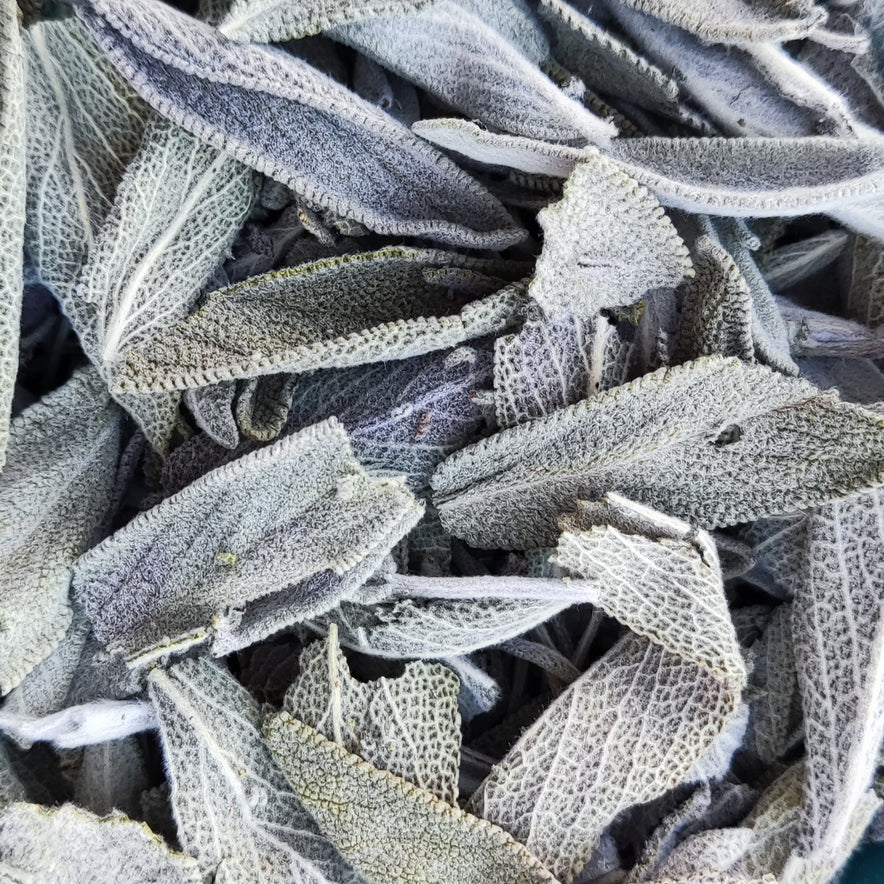
Sage (Salvia Officinalis) | Organic
The mint family's common sage (salvia officinalis) is said to have emerged in the Mediterranean. The Latin name for it, Salvia officinalis, refers to its extensive usage as a medical herb. Salvia is derived from the Latin word" salvere", which means "to be healed" or "to cure." The term officinalis alludes to an "officina", which is a special chamber in a monastery functioning as a storage facility for plants and medicines.
For thousands of years, sage has been a key component of traditional medicine. Sage has been used traditionally by herbalists to treat a broad range of diseases and problems, including swelling, and infection, or used for pain reduction, and even for memory improvement.
Sage tea has been praised for its potential to aid digestion, prevent diarrhea, and bring comfort to women suffering from severe menstrual cramps. It's even been used to ease discomfort linked with sore throats, bleeding gums, and mouth-related ulcers when prepared as a gargle or mouth wash – and these are just some of the traditional therapeutic perks and applications.
Some of the documented sage advantages in contemporary medicine include assisting with Alzheimer's and dementia, treating diabetic symptoms, balancing cholesterol, combatting obesity, managing menopausal symptoms, and easing diarrhea.
Sage advantages also include providing an excellent garden addition, eliminating garden pests, and attracting pollinators.
You may also burn sage to enhance your mood, use it in cleaning goods, add it to bath salts, and use sage essential oil on your skin.
It is also well-known for its culinary applications, and it is a favorite among kitchen herbalists all over the world for a range of dishes and cuisines.
Recommended Dosage
◉ 1-3 teaspoons of loose tea (or 3g up to 3 times) daily. If more than one herbal mixture is consumed at the same period of time, reduce the amount of tea accordingly.
◉ When herbs are used for an extended period of time, it is suggested to consume a herbal remedy with a ratio of 3 to 1. For example:
- If you choose to take it for 3 weeks, have a one-week pause.
- If it is taken for a 30-day period, have a 10-day pause.
That does not apply to herbs and fruits that have a laxative effect.
Notes
◉ Should be stored in airtight glass containers -in a cool, dark, and dry place- to preserve the flavor, texture, and properties.
◉ Before adding a new herbal remedy or supplement to your daily routine, you should consult with a medical doctor or holistic health practitioner.
Herbal Tea Brewing Instructions
- Hot Brew
- Heat the water to just the point when it starts to boil.
- Add 1 teaspoon of loose tea, to a tea infuser or tea bag, for every 180ml - 240ml of water.
- Pour the heated water (right off the boil) over the tea, cover your cup, and steep for 7-10 minutes or longer.
- Add honey or stevia for sweetness, if desired.
- Cold Brew
A cold infusion delivers flavors that are sweeter, smoother, more complex, and can be made in a number of different ways.
-
The Fast Way (Best For Herbal Tea)
Follow the steps as shown in the "Hot Brew", but use less water, and perhaps even more tea, in order to produce tea concentrate.
Strain and pour over ice or cold water. -
Overnight Ice Tea
Add 1-2 teaspoons of loose tea to a tea infuser or tea bag, for every 200ml - 250ml of water. Pour room-temperature water over the tea, stir, cover, and refrigerate for 6 to 12 hours.
Follow these additional steps to make the perfect cup of tea!
